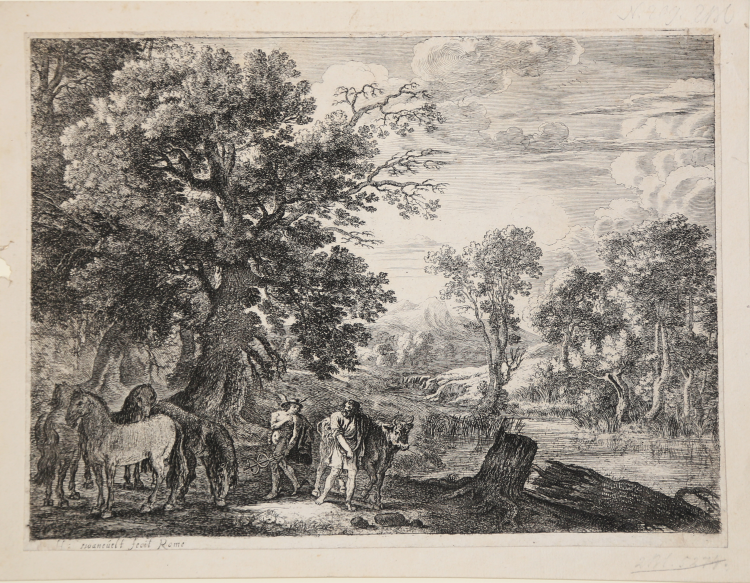



| Reference: | S35351 |
| Author | Herman van SWANEVELT |
| Year: | 1630 ca. |
| Measures: | 265 x 195 mm |


| Reference: | S35351 |
| Author | Herman van SWANEVELT |
| Year: | 1630 ca. |
| Measures: | 265 x 195 mm |
Etching, circa 1629-41, Lettered in lower margin ' H. Swanevelt fecit Rome. A fine impression of the first state of two, before the Valdor's address.
Printed with tone on contemporary laid paper, trimmed to the platemark and laid down on antique mounting, good condition.
Mercury turning Battus into stone; view of a river valley with Mercury with a winged helm standing at right, pointing the caduceus at Battus, who is turning his head back towards Mercury as he steps to left with his right hand resting on the bull's back.
Herman van Swanevelt, known as Herman d'Italie (Woerden, 1603 - Paris, 1655), was a Dutch painter, draughtsman and engraver. He also produced a large number of high-quality engravings, which (as in the case of Rembrandt), increased his fame among both his contemporaries and posterity. According to some scholars, his etchings are even far superior to the paintings, due to the prevalence in these of a cold green hue in the foreground and middle ground and for being the latter too heavy, dark, and gloomy. He had a peculiar way of engraving: he expressed himself with somewhat curved horizontal strokes. He emphasized contours little, except to distinguish masses. He used the dry point and more the burin, to give harmony. He also left several drawings, often preparatory studies for his paintings, which were also of excellent workmanship.
Bibliografia
Hollstein, Dutch and Flemish etchings, engravings and woodcuts c.1450-1700 16-5 (6).
Herman van SWANEVELT (Woerden 1603 - Parigi 1655)
|
Herman was born in Woerden to a family of thriving artisans whose ancestors included the famous painter Lucas van Leyden. The identity of Swanevelt’s teacher remains a mystery. A new hypothesis suggests that he was a pupil of Willem Buytewech. He painted his first signed and dated works in 1623 in Paris. In 1629 he moved to Rome, where he painted many landscapes, and introduced a new type of idyllic landscape with sunlit 'contrejours' reflecting the times of day. Swanevelt became a member of the Bentvueghels; his alias was "heremiet", while he preferred to work alone.
Created and developed by Paul Bril and Cornelis van Poelenburch from 1600 onward, the genre of the “Italianate landscape” entered its classical phase in the 1630s with the advent of Swanevelt and his friends and contemporaries Pieter van Laer and Claude Lorrain. His paintings became very popular and the Barberini family, Pope Urban VIII and the Vatican offered him commissions, like in the monastery of Monte Cassino. Along with Lorrain and others, he also painted landscapes for Philip IV of Spain's new Buen Retiro Palace in Madrid.
In 1641 he returned to Paris, where he remained except for occasional visits to his birthplace Woerden. He became a member of the Académie Royale de Peinture et de Sculpture in 1651. He assisted in the decoration of the Hôtel Lambert and made numerous drawings and etchings. His patrons in France were Cardinal Richelieu and King Louis XIV. Swanevelt lived in Rue du Temple when he died.
|
Herman van SWANEVELT (Woerden 1603 - Parigi 1655)
|
Herman was born in Woerden to a family of thriving artisans whose ancestors included the famous painter Lucas van Leyden. The identity of Swanevelt’s teacher remains a mystery. A new hypothesis suggests that he was a pupil of Willem Buytewech. He painted his first signed and dated works in 1623 in Paris. In 1629 he moved to Rome, where he painted many landscapes, and introduced a new type of idyllic landscape with sunlit 'contrejours' reflecting the times of day. Swanevelt became a member of the Bentvueghels; his alias was "heremiet", while he preferred to work alone.
Created and developed by Paul Bril and Cornelis van Poelenburch from 1600 onward, the genre of the “Italianate landscape” entered its classical phase in the 1630s with the advent of Swanevelt and his friends and contemporaries Pieter van Laer and Claude Lorrain. His paintings became very popular and the Barberini family, Pope Urban VIII and the Vatican offered him commissions, like in the monastery of Monte Cassino. Along with Lorrain and others, he also painted landscapes for Philip IV of Spain's new Buen Retiro Palace in Madrid.
In 1641 he returned to Paris, where he remained except for occasional visits to his birthplace Woerden. He became a member of the Académie Royale de Peinture et de Sculpture in 1651. He assisted in the decoration of the Hôtel Lambert and made numerous drawings and etchings. His patrons in France were Cardinal Richelieu and King Louis XIV. Swanevelt lived in Rue du Temple when he died.
|